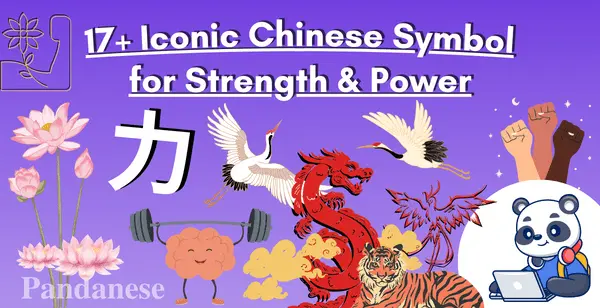
17+ Iconic Chinese Symbol for Strength & Power
Symbolism holds a special place in Chinese culture, and two of its most esteemed concepts are strength and power.
We will explore the fascinating representation of these ideas in the Chinese language, uncovering the profound symbolism behind characters, animals, and common sayings (chengyu) that embody strength and power.
Join us as we explore the rich cultural expressions of these concepts and their significance in Chinese tradition.
The Chinese symbol for strength and power
1. 力 (lì)
The concept of strength and power is expressed by the Chinese character 力 (lì), which is a pictograph of a plow: since a great amount of strength is needed to move a plow, it makes sense that this object was used as a reference to design this character.
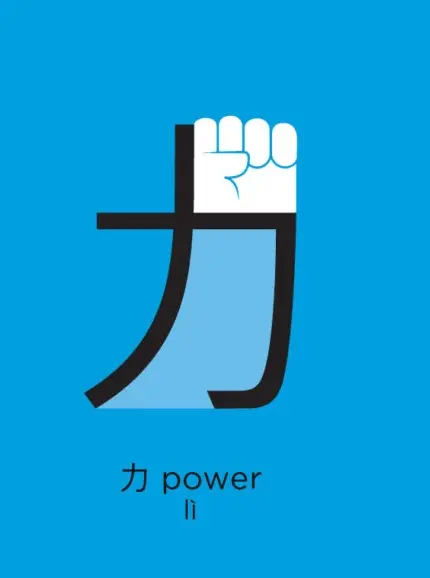
The traditional Chinese text character of 力 | Chinese blog
Take a look at the video below to see its origin and how including 力 involves power and force in the overall meaning.
Origin and different depictions of 力If you are looking for a platform that allows you to learn Chinese characters in a quick, efficient, and fun way, check out Pandanese. This web app combines SRS and mnemonics to help you memorize radicals, characters, and Chinese vocabulary by suggesting how to remember their shape or sound to their meaning.
Bonus: compound words with 力
The majority of Chinese words used in everyday conversations are comprised of two syllables.
So, the character 力 is often combined with other characters to form these words. Let's have a look at some of them.
2. 力量 (lìliàng)
When talking about both physical or inner strength, use the word 力量 (lìliàng). It is a combination of "力" (lì), meaning "force" or "power," and "量" (liàng), which translates to "quantity" or "amount."
Take a look at this saying: 个人的力量是很有限的。(Gèrén de lìliàng shì hěn yǒuxiàn de.) "The power of an individual is very limited."
3. 权力 (quánlì)
This Chinese word for power is formed by "权" (quán), denoting "authority" or "power," and "力" (lì), which, as mentioned earlier, means "force" or "strength."
The combination highlights the concept of authority backed by strength.
Look at this sentence: 老师没有体罚学生的权力。(Lǎoshī méiyǒu tǐfá xuéshēng de quánlì.) Teachers do not have the right to punish students physically.
权力 is just one of the many words formed by adding 力 as a suffix. When you see a word ending with lì, it most likely refers to some ability or power specified by the first character.
The following words are some examples:
4. 功力 (gōnglì)
Breaking down this vocabulary, 功 (gōng) generally indicates "achievement" or "merit."
Together, “功力” (gōnglì) conveys the idea of "skill" or "proficiency" gained through continuous practice, dedication, and effort over time. It is often used in martial arts or other specialized fields to describe the mastery or expertise achieved by someone through training and experience.
Take a look at this example: 从这幅字可以看出爷爷在书法上的深厚功力。 (Cóng zhè fú zì kěyǐ kàn chū yéyé zài shūfǎ shàng de shēnhòu gōng lì.) "From this piece of calligraphy, you can see Grandpa's excellent calligraphy skills."
5. 听力 (tīnglì)
This word means "listening ability," which is also part of the HSK exam. If you are studying Chinese at school, you will likely have some listening classes called 听力课 (tīnglì kè).
Example sentence: 我的听力没有他的好。(Wǒ de tīnglì méiyǒu tā de hǎo.) "My listening skills are not as good as his."
6. 能力 (nénglì)
This Chinese word means "ability" or "capability."
Example sentence: 她有很强的领导能力。(Tā yǒu hěn qiáng de lǐngdǎo nénglì) "She has strong leadership abilities."
7. 风力 (fēnglì), 水力 (shuǐlì), 电力 (diànlì)
These words all refer to kinds of power. If you know the meaning of the first part of the words, they're quite easy to understand: 风力 means wind power, 水力 means hydraulic power, while 电力 means electric power.
Example: 开发水力资源,有利于保护自然环境。(Kāifā shuǐlì zīyuán, yǒulì yú bǎohù zìrán huánjìng.) Developing hydropower resources is beneficial for protecting the natural environment."
These were just some Chinese words formed by placing 力 as a suffix. Still, there are many more: 稳定力 (wěndìng lì), formed by "stable" + "power" means stability, 创造力 (chuàngzào lì), formed by "to create" + "power," means creativity, 思考力 (sīkǎo lì), formed by "to think" + "power" means thinking ability, and so on.
There are many words containing the hanzi 力 in HSK exams levels 1-6. The video below explains some of them.
Chinese Word Root for 力 | Daily ZhongwenMandarin Temple is a great resource for knowing more about the character 力 and compound words.
Animals representing power and strength in Chinese culture
The concepts of power and strength are also associated with some symbols, such as animals and plants. The most popular Chinese symbols for strength are:
8. Tiger: 虎 (hǔ)
The tiger is a Chinese symbol of strength. It symbolizes protection, bravery, and a dominating presence.
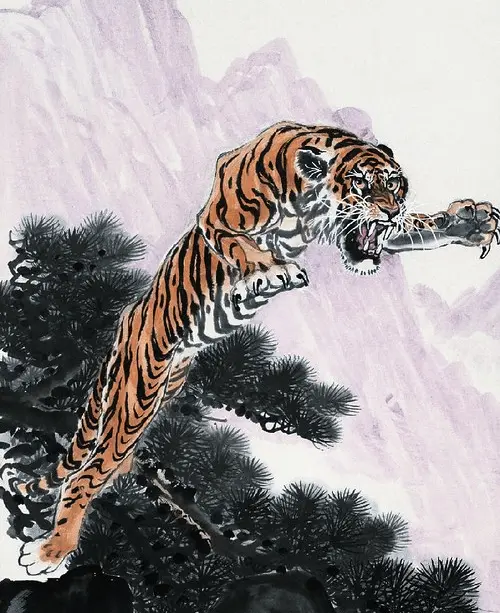
Painting by Hu Shuang'an (胡爽庵, 1916-1988) | China Online Museum
9. Dragon: 龙 (lóng)
Perhaps the most iconic and revered symbol in Chinese culture, the dragon represents ultimate power, strength, and good fortune. In ancient China, it was associated with the Emperor and considered a guardian of the heavens: for this reason, this animal is omnipresent in Chinese art.
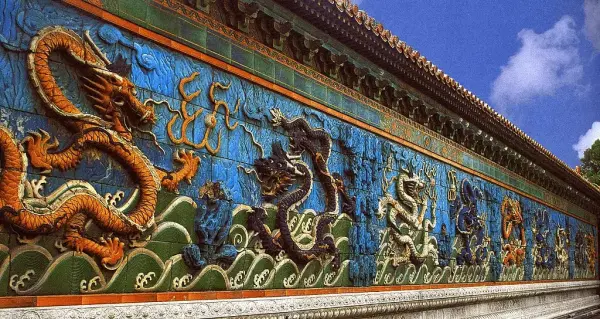
Nine-Dragon Wall in Beijing | Wikimedia
10. Phoenix: 凤凰 (fèng huáng)
While commonly associated with grace and beauty, the phoenix also represents power and resilience. This legendary animal rises from the ashes and symbolizes renewal and strength through adversity.
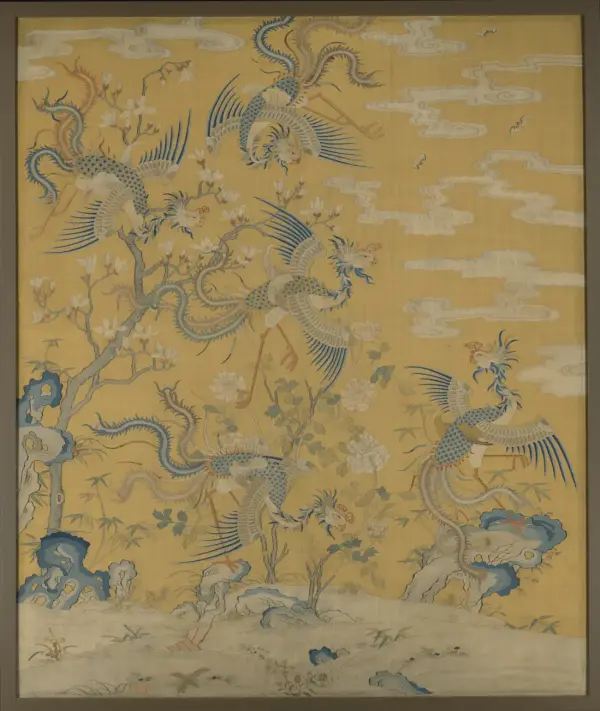
Panel with five phoenixes in a garden from the Qing dynasty (1644–1911) | Met Museum
11. Crane: 鹤 (hè)
The crane is associated with longevity and strength. In Chinese mythology, it is said to possess the power to carry souls to heaven.
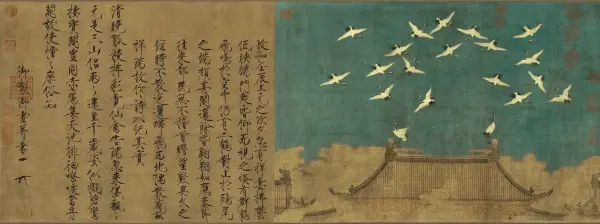
"Auspicious Cranes" painted by Zhao Ji (1082–1135) by China online museum
Chinese flower for strength:
12. Lotus flower: 莲花 (liánhuā)
If you're learning Chinese, you're probably familiar with Chinese chengyu. These expressions are usually composed of 4 characters and carry an idiomatic meaning.
This aquatic plant grows through dark and muddy water until it reaches the surface and opens its petals in full bloom: the obstacles it must overcome to reach the surface are symbolic of the obstacles one must overcome to achieve one's goals or success.

Chinese idiomatic expression about strength and power
If you're learning Chinese, you're probably familiar with Chinese chengyu. These expressions are usually composed of 4 characters and carry an idiomatic meaning.
Here are some chengyu associated with the concepts of strength and power:
13.力大无穷 (lì dà wú qióng)
Translated as "boundless strength," this saying emphasizes that true strength knows no limits.
Example: 他是个力大无穷的人。(Tā shì gè lì dà wú qióng de rén.) "He is a person with boundless strength."
14. 力不从心 (lì bù cóng xīn)
It translates to "strength unable to follow the heart." It means one's ability or strength is not as strong as one would wish; the spirit is willing, but the flesh is weak.
Example: 我真的想学好汉语,但是汉字太多了,力不从心。(Wǒ zhēn de xiǎng xué hǎo hànyǔ, dànshì hànzì tài duō le, lì bù cóng xīn.) "I really want to learn Chinese, but there are so many characters that it's overwhelming."
15. 力挽狂澜 (lì wǎn kuáng lán)
This chengyu translates to "to pull back a raging wave." It means trying hard to save a desperate crisis.
Example: 关键时刻,他力挽狂澜,挽救了企业。(Guānjiàn shíkè, tā lì wǎn kuáng lán, wǎnjiù le qǐyè.) "He pulled back the surging waves and saved the company at a critical moment."
16. 如虎添翼 (rú hǔ tiān yì)
"As a tiger gains wings" signifies empowering someone or something further, making them even stronger and more formidable.
Example: 得到小华的帮助,我们如虎添翼最先完成了任务。(Dé dào Xiǎo Huá de bāngzhù, wǒmen rú hǔ tiān yì zuì xiān wánchéng le rènwù.) "With Xiao Hua's help, we were like a tiger growing wings and completed the task first."
The concept of inner strength in Chinese
17. 内功 (nèi gōng): inner strength
Generally, in Chinese culture, especially in martial arts, the concept of strength is associated with the idea of 内功 (nèi gōng) or "inner strength."
Unlike 外功 (wài gōng) or "external strength," which focuses on physical techniques and conditioning, 内功 emphasizes cultivating the power within oneself. It is often considered more vital than relying solely on physical power.
Practitioners of 内功 devote themselves to various forms of training, including breathing exercises, meditation, and energy circulation techniques, to enhance their internal energy or 气 (qì).
The importance of "内功" extends beyond martial arts, influencing various aspects of Chinese culture and philosophy: for example, the idea of nurturing inner strength is deeply rooted in traditional Chinese beliefs about the balance of Yin and Yang, the flow of energy through the body, and the harmony between mind, body, and spirit. This approach also characterizes traditional Chinese medicine and Taoist practices.
Inner strength in Chinese mythology
Chinese mythology is rich with tales of strong and powerful legendary figures like Guan Yu, renowned for his loyalty and exceptional ability in martial arts, exemplifying the integration of 内功 and 外功 to achieve greatness. Guan Yu's bravery in the face of adversity made him an iconic symbol of loyalty and righteousness in Chinese culture.
Similarly, the legendary heroine Mulan, famous for disguising herself as a man to join the army, is another powerful example of strength in Chinese culture, as she demonstrated physical courage and strength of character, determination, and resourcefulness.
These stories highlight the significance of inner strength and its role in shaping individuals into heroes and icons of virtue.
In modern times, the concept of 内功 remains relevant in Chinese martial arts and continues to inspire individuals to seek personal development beyond physical limitations. This concept represents a holistic approach to self-improvement and promotes cultivating one's character, willpower, and resilience alongside physical abilities.
In Chinese culture, strength is ultimately the result of an interconnected relationship between mind, body, and spirit.
Frequently asked questions
What animal symbolizes strength in Chinese culture?
The tiger 虎 (hǔ), the dragon 龙 (lóng), the phoenix 凤凰 (fèng huáng), the crane 鹤 (hè) all symbolize strength in Chinese culture.
What Chinese animals represent strength?
Typically, the Tiger 虎 (hǔ) represents strength as well as protection and bravery.
What are powerful symbols in Chinese culture?
Without going too depth, the dragon 龙 (lóng) is one of the most powerful symbols in Chinese culture.
To wrap up
There is no Chinese symbol for strength, but instead many representation and Chinese symbols for this meaning. Thus, strength and power hold profound significance for Chinese people and are expressed through many symbols, characters, animals, and sayings: I hope this article provided insight and gave you the necessary strength to pursue your goals!
Elisa Felici has been studying Chinese since 2014. She started her language-learning journey at Italian universities and lived in Beijing while attending Beijing’s Confucius Institute. Elisa passed HSK 4 and 5 and finally, in 2020, HSK 6. She now has a Master’s degree in translation and interpreting and has experience not only as a language learner but also as a Chinese teacher and translator.
The easiest way to learn Chinese & build vocabulary

